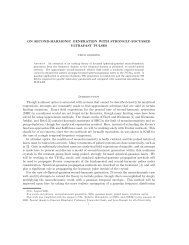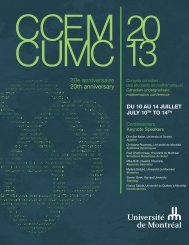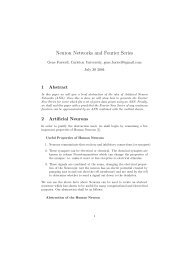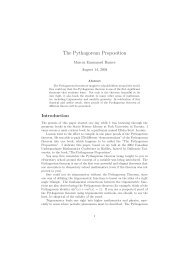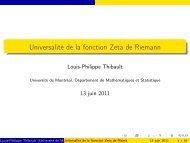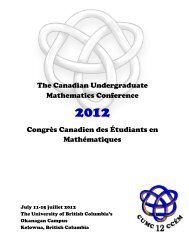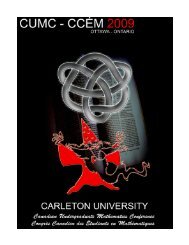The Foundations of Path Integration in Quantum Mechanics ... - CUMC
The Foundations of Path Integration in Quantum Mechanics ... - CUMC
The Foundations of Path Integration in Quantum Mechanics ... - CUMC
You also want an ePaper? Increase the reach of your titles
YUMPU automatically turns print PDFs into web optimized ePapers that Google loves.
Orthodox <strong>Quantum</strong> <strong>The</strong>ory<br />
Pilot-Wave <strong>The</strong>ory<br />
De Broglie-Bohm and Feynman <strong>Path</strong> Integrals<br />
<strong>The</strong> <strong>Foundations</strong> <strong>of</strong> <strong>Path</strong> <strong>Integration</strong> <strong>in</strong><br />
<strong>Quantum</strong> <strong>Mechanics</strong>: From de Broglie to Feynman<br />
Marius Oltean<br />
Department <strong>of</strong> Applied Mathematics, University <strong>of</strong> Waterloo<br />
200 University Ave W, Waterloo ON, N2L 3G1, Canada<br />
Canadian Undergraduate Mathematics Conference, Québec — June 17, 2011<br />
M. Oltean, Waterloo Mathematics Review 1, 1 (2011).<br />
Marius Oltean<br />
<strong>The</strong> <strong>Foundations</strong> <strong>of</strong> <strong>Path</strong> <strong>Integration</strong> <strong>in</strong> <strong>Quantum</strong> <strong>Mechanics</strong>
Orthodox <strong>Quantum</strong> <strong>The</strong>ory<br />
Pilot-Wave <strong>The</strong>ory<br />
De Broglie-Bohm and Feynman <strong>Path</strong> Integrals<br />
Outl<strong>in</strong>e<br />
1 Orthodox <strong>Quantum</strong> <strong>The</strong>ory<br />
Development and Axioms<br />
<strong>The</strong> Measurement Problem<br />
2 Pilot-Wave <strong>The</strong>ory<br />
Development and Axioms<br />
Empirical Implications and Criticisms<br />
3 De Broglie-Bohm and Feynman <strong>Path</strong> Integrals<br />
<strong>The</strong> De Broglie-Bohm <strong>Path</strong> Integral<br />
<strong>The</strong> Feynman <strong>Path</strong> Integral<br />
Marius Oltean<br />
<strong>The</strong> <strong>Foundations</strong> <strong>of</strong> <strong>Path</strong> <strong>Integration</strong> <strong>in</strong> <strong>Quantum</strong> <strong>Mechanics</strong>
Orthodox <strong>Quantum</strong> <strong>The</strong>ory<br />
Pilot-Wave <strong>The</strong>ory<br />
De Broglie-Bohm and Feynman <strong>Path</strong> Integrals<br />
<strong>The</strong> World Before 1900<br />
Development and Axioms<br />
<strong>The</strong> Measurement Problem<br />
“In a few years, all great physical constants will have<br />
been approximately estimated, and the only occupation<br />
which will be left to men <strong>of</strong> science will be to carry<br />
these measurements to another place <strong>of</strong> decimals.”<br />
— J. C. Maxwell (Scientific Papers, 1871)<br />
Classical physics. <strong>Mechanics</strong>, electrodynamics, statistical thermodynamics:<br />
∇ 2 Φ = 4πGρ, mẍ = −∇Φ.<br />
∇ · B = 0, ∇ · E = ρ/ε 0, ∇ × E = −∂ tB, ∇ × B = µ 0J + µ 0ε 0∂ tE.<br />
S = k ln Ω.<br />
Marius Oltean<br />
<strong>The</strong> <strong>Foundations</strong> <strong>of</strong> <strong>Path</strong> <strong>Integration</strong> <strong>in</strong> <strong>Quantum</strong> <strong>Mechanics</strong>
Orthodox <strong>Quantum</strong> <strong>The</strong>ory<br />
Pilot-Wave <strong>The</strong>ory<br />
De Broglie-Bohm and Feynman <strong>Path</strong> Integrals<br />
<strong>The</strong> World Before 1900<br />
Development and Axioms<br />
<strong>The</strong> Measurement Problem<br />
“In a few years, all great physical constants will have<br />
been approximately estimated, and the only occupation<br />
which will be left to men <strong>of</strong> science will be to carry<br />
these measurements to another place <strong>of</strong> decimals.”<br />
— J. C. Maxwell (Scientific Papers, 1871)<br />
Classical physics. <strong>Mechanics</strong>, electrodynamics, statistical thermodynamics:<br />
∇ 2 Φ = 4πGρ, mẍ = −∇Φ.<br />
∇ · B = 0, ∇ · E = ρ/ε 0, ∇ × E = −∂ tB, ∇ × B = µ 0J + µ 0ε 0∂ tE.<br />
S = k ln Ω.<br />
Marius Oltean<br />
<strong>The</strong> <strong>Foundations</strong> <strong>of</strong> <strong>Path</strong> <strong>Integration</strong> <strong>in</strong> <strong>Quantum</strong> <strong>Mechanics</strong>
Orthodox <strong>Quantum</strong> <strong>The</strong>ory<br />
Pilot-Wave <strong>The</strong>ory<br />
De Broglie-Bohm and Feynman <strong>Path</strong> Integrals<br />
Development and Axioms<br />
<strong>The</strong> Measurement Problem<br />
Dawn <strong>of</strong> the 20th Century: Particle or Wave<br />
“It was as if the ground had been pulled out from<br />
under one, with no firm foundation to be seen<br />
anywhere, upon which one could have built.”<br />
— A. E<strong>in</strong>ste<strong>in</strong> (Philosopher-Scientist, 1949)<br />
Marius Oltean<br />
<strong>The</strong> <strong>Foundations</strong> <strong>of</strong> <strong>Path</strong> <strong>Integration</strong> <strong>in</strong> <strong>Quantum</strong> <strong>Mechanics</strong>
Orthodox <strong>Quantum</strong> <strong>The</strong>ory<br />
Pilot-Wave <strong>The</strong>ory<br />
De Broglie-Bohm and Feynman <strong>Path</strong> Integrals<br />
<strong>The</strong> 1927 Solvay Conference<br />
Development and Axioms<br />
<strong>The</strong> Measurement Problem<br />
Marius Oltean<br />
<strong>The</strong> <strong>Foundations</strong> <strong>of</strong> <strong>Path</strong> <strong>Integration</strong> <strong>in</strong> <strong>Quantum</strong> <strong>Mechanics</strong>
Orthodox <strong>Quantum</strong> <strong>The</strong>ory<br />
Pilot-Wave <strong>The</strong>ory<br />
De Broglie-Bohm and Feynman <strong>Path</strong> Integrals<br />
Development and Axioms<br />
<strong>The</strong> Measurement Problem<br />
Axioms <strong>of</strong> Orthodox <strong>Quantum</strong> <strong>The</strong>ory<br />
Complete Description. For a system <strong>of</strong> N particles:<br />
ψ : R 3N × R → C<br />
(q, t) = (q 1 , ..., q N , t) ↦→ ψ (q, t)<br />
Axiom 1. <strong>The</strong> Schröd<strong>in</strong>ger equation:<br />
When no ‘measurement’ is be<strong>in</strong>g performed, the wavefunction evolves via<br />
i ∂ψ<br />
N<br />
∂t = ∑ − 2<br />
∇ 2 j ψ + V ψ.<br />
2m j<br />
j =1<br />
Axiom 2. <strong>The</strong> von Neumann projection postulate:<br />
Upon ‘measurement’, the wavefunction randomly ‘collapses’ onto one <strong>of</strong><br />
all the possible outcomes (eigenfunctions <strong>of</strong> the Hilbert space operator<br />
correspond<strong>in</strong>g thereto), which have p.d.f. ρ (q, t) = |ψ (q, t) | 2 .<br />
Marius Oltean<br />
<strong>The</strong> <strong>Foundations</strong> <strong>of</strong> <strong>Path</strong> <strong>Integration</strong> <strong>in</strong> <strong>Quantum</strong> <strong>Mechanics</strong>
Orthodox <strong>Quantum</strong> <strong>The</strong>ory<br />
Pilot-Wave <strong>The</strong>ory<br />
De Broglie-Bohm and Feynman <strong>Path</strong> Integrals<br />
Development and Axioms<br />
<strong>The</strong> Measurement Problem<br />
Axioms <strong>of</strong> Orthodox <strong>Quantum</strong> <strong>The</strong>ory<br />
Complete Description. For a system <strong>of</strong> N particles:<br />
ψ : R 3N × R → C<br />
(q, t) = (q 1 , ..., q N , t) ↦→ ψ (q, t)<br />
Axiom 1. <strong>The</strong> Schröd<strong>in</strong>ger equation:<br />
When no ‘measurement’ is be<strong>in</strong>g performed, the wavefunction evolves via<br />
i ∂ψ<br />
N<br />
∂t = ∑ − 2<br />
∇ 2 j ψ + V ψ.<br />
2m j<br />
j =1<br />
Axiom 2. <strong>The</strong> von Neumann projection postulate:<br />
Upon ‘measurement’, the wavefunction randomly ‘collapses’ onto one <strong>of</strong><br />
all the possible outcomes (eigenfunctions <strong>of</strong> the Hilbert space operator<br />
correspond<strong>in</strong>g thereto), which have p.d.f. ρ (q, t) = |ψ (q, t) | 2 .<br />
Marius Oltean<br />
<strong>The</strong> <strong>Foundations</strong> <strong>of</strong> <strong>Path</strong> <strong>Integration</strong> <strong>in</strong> <strong>Quantum</strong> <strong>Mechanics</strong>
Orthodox <strong>Quantum</strong> <strong>The</strong>ory<br />
Pilot-Wave <strong>The</strong>ory<br />
De Broglie-Bohm and Feynman <strong>Path</strong> Integrals<br />
Development and Axioms<br />
<strong>The</strong> Measurement Problem<br />
Axioms <strong>of</strong> Orthodox <strong>Quantum</strong> <strong>The</strong>ory<br />
Complete Description. For a system <strong>of</strong> N particles:<br />
ψ : R 3N × R → C<br />
(q, t) = (q 1 , ..., q N , t) ↦→ ψ (q, t)<br />
Axiom 1. <strong>The</strong> Schröd<strong>in</strong>ger equation:<br />
When no ‘measurement’ is be<strong>in</strong>g performed, the wavefunction evolves via<br />
i ∂ψ<br />
N<br />
∂t = ∑ − 2<br />
∇ 2 j ψ + V ψ.<br />
2m j<br />
j =1<br />
Axiom 2. <strong>The</strong> von Neumann projection postulate:<br />
Upon ‘measurement’, the wavefunction randomly ‘collapses’ onto one <strong>of</strong><br />
all the possible outcomes (eigenfunctions <strong>of</strong> the Hilbert space operator<br />
correspond<strong>in</strong>g thereto), which have p.d.f. ρ (q, t) = |ψ (q, t) | 2 .<br />
Marius Oltean<br />
<strong>The</strong> <strong>Foundations</strong> <strong>of</strong> <strong>Path</strong> <strong>Integration</strong> <strong>in</strong> <strong>Quantum</strong> <strong>Mechanics</strong>
Orthodox <strong>Quantum</strong> <strong>The</strong>ory<br />
Pilot-Wave <strong>The</strong>ory<br />
De Broglie-Bohm and Feynman <strong>Path</strong> Integrals<br />
Two Conceptions <strong>of</strong> Science<br />
Development and Axioms<br />
<strong>The</strong> Measurement Problem<br />
“Physics is to be regarded not so<br />
much as the study <strong>of</strong> someth<strong>in</strong>g a<br />
priori given, but rather as the<br />
development <strong>of</strong> methods <strong>of</strong> order<strong>in</strong>g<br />
and survey<strong>in</strong>g human experience.”<br />
— N. Bohr (<strong>The</strong> Unity <strong>of</strong> Human<br />
Knowledge, 1960)<br />
Marius Oltean<br />
“If one renounces the assumption that<br />
what is present <strong>in</strong> different parts <strong>of</strong><br />
space has an <strong>in</strong>dependent, real<br />
existence, then I do not at all see<br />
what physics is supposed to describe.”<br />
— A. E<strong>in</strong>ste<strong>in</strong> (note to Born, 1948)<br />
<strong>The</strong> <strong>Foundations</strong> <strong>of</strong> <strong>Path</strong> <strong>Integration</strong> <strong>in</strong> <strong>Quantum</strong> <strong>Mechanics</strong>
Orthodox <strong>Quantum</strong> <strong>The</strong>ory<br />
Pilot-Wave <strong>The</strong>ory<br />
De Broglie-Bohm and Feynman <strong>Path</strong> Integrals<br />
Development and Axioms<br />
<strong>The</strong> Measurement Problem<br />
What is Wrong with Orthodox <strong>Quantum</strong> <strong>The</strong>ory<br />
As a phenomenological formalism: Noth<strong>in</strong>g at all – Axioms 1 and 2<br />
have proven enormously successful <strong>in</strong> the prediction <strong>of</strong> experimental<br />
regularities <strong>in</strong> a wide range <strong>of</strong> atomic phenomena.<br />
As a theory <strong>of</strong> fundamental physics: A great deal – recall:<br />
Axiom 1. <strong>The</strong> Schröd<strong>in</strong>ger equation:<br />
When no ‘measurement’ is be<strong>in</strong>g performed,<br />
i ∂ψ<br />
N<br />
∂t = ∑ − 2<br />
∇ 2 j ψ + V ψ.<br />
2m j<br />
j =1<br />
Axiom 2. <strong>The</strong> von Neumann projection postulate:<br />
Upon ‘measurement’, ψ randomly ‘collapses’ with p.d.f. ρ = |ψ| 2 .<br />
Marius Oltean<br />
<strong>The</strong> <strong>Foundations</strong> <strong>of</strong> <strong>Path</strong> <strong>Integration</strong> <strong>in</strong> <strong>Quantum</strong> <strong>Mechanics</strong>
Orthodox <strong>Quantum</strong> <strong>The</strong>ory<br />
Pilot-Wave <strong>The</strong>ory<br />
De Broglie-Bohm and Feynman <strong>Path</strong> Integrals<br />
Development and Axioms<br />
<strong>The</strong> Measurement Problem<br />
What is Wrong with Orthodox <strong>Quantum</strong> <strong>The</strong>ory<br />
As a phenomenological formalism: Noth<strong>in</strong>g at all – Axioms 1 and 2<br />
have proven enormously successful <strong>in</strong> the prediction <strong>of</strong> experimental<br />
regularities <strong>in</strong> a wide range <strong>of</strong> atomic phenomena.<br />
As a theory <strong>of</strong> fundamental physics: A great deal – recall:<br />
Axiom 1. <strong>The</strong> Schröd<strong>in</strong>ger equation:<br />
When no ‘measurement’ is be<strong>in</strong>g performed,<br />
i ∂ψ<br />
N<br />
∂t = ∑ − 2<br />
∇ 2 j ψ + V ψ.<br />
2m j<br />
j =1<br />
Axiom 2. <strong>The</strong> von Neumann projection postulate:<br />
Upon ‘measurement’, ψ randomly ‘collapses’ with p.d.f. ρ = |ψ| 2 .<br />
Marius Oltean<br />
<strong>The</strong> <strong>Foundations</strong> <strong>of</strong> <strong>Path</strong> <strong>Integration</strong> <strong>in</strong> <strong>Quantum</strong> <strong>Mechanics</strong>
Orthodox <strong>Quantum</strong> <strong>The</strong>ory<br />
Pilot-Wave <strong>The</strong>ory<br />
De Broglie-Bohm and Feynman <strong>Path</strong> Integrals<br />
<strong>The</strong> Measurement Problem<br />
Development and Axioms<br />
<strong>The</strong> Measurement Problem<br />
One possible formulation: If orthodox quantum theory is correct, then<br />
why are the laws <strong>of</strong> physics cont<strong>in</strong>gent upon the act <strong>of</strong> ‘measurement’<br />
(which is, <strong>in</strong> any event, a very vaguely def<strong>in</strong>ed concept)<br />
<br />
“Does this mean that my observations become real<br />
only when I observe an observer observ<strong>in</strong>g someth<strong>in</strong>g<br />
as it happens This is a horrible viewpo<strong>in</strong>t. Do you<br />
seriously enterta<strong>in</strong> the thought that without observer<br />
there is no reality Which observer Any observer Is<br />
a fly an observer Is a star an observer Was there no<br />
reality before 10 9 B.C. before life began Or are you<br />
the observer <strong>The</strong>n there is no reality to the world<br />
after you are dead [...] By what philosophy will the<br />
Universe without man be understood”<br />
— R. Feynman (Feynman Lectures on Gravitation)<br />
Marius Oltean<br />
<strong>The</strong> <strong>Foundations</strong> <strong>of</strong> <strong>Path</strong> <strong>Integration</strong> <strong>in</strong> <strong>Quantum</strong> <strong>Mechanics</strong>
Orthodox <strong>Quantum</strong> <strong>The</strong>ory<br />
Pilot-Wave <strong>The</strong>ory<br />
De Broglie-Bohm and Feynman <strong>Path</strong> Integrals<br />
<strong>The</strong> Part<strong>in</strong>g <strong>of</strong> the Ways<br />
Development and Axioms<br />
<strong>The</strong> Measurement Problem<br />
Conclusion: Orthodox quantum theory must be abandoned.<br />
But what other options are there<br />
Alternative, empirically equivalent formulations <strong>of</strong> quantum mechanics<br />
Pilot-wave theory<br />
Objective collapse theories<br />
Many worlds theories<br />
<strong>Quantum</strong> Bayesianism<br />
Ensemble <strong>in</strong>terpretation<br />
and so on...<br />
Marius Oltean<br />
<strong>The</strong> <strong>Foundations</strong> <strong>of</strong> <strong>Path</strong> <strong>Integration</strong> <strong>in</strong> <strong>Quantum</strong> <strong>Mechanics</strong>
Orthodox <strong>Quantum</strong> <strong>The</strong>ory<br />
Pilot-Wave <strong>The</strong>ory<br />
De Broglie-Bohm and Feynman <strong>Path</strong> Integrals<br />
<strong>The</strong> Part<strong>in</strong>g <strong>of</strong> the Ways<br />
Development and Axioms<br />
<strong>The</strong> Measurement Problem<br />
Conclusion: Orthodox quantum theory must be abandoned.<br />
But what other options are there<br />
Alternative, empirically equivalent formulations <strong>of</strong> quantum mechanics<br />
Pilot-wave theory<br />
Objective collapse theories<br />
Many worlds theories<br />
<strong>Quantum</strong> Bayesianism<br />
Ensemble <strong>in</strong>terpretation<br />
and so on...<br />
Marius Oltean<br />
<strong>The</strong> <strong>Foundations</strong> <strong>of</strong> <strong>Path</strong> <strong>Integration</strong> <strong>in</strong> <strong>Quantum</strong> <strong>Mechanics</strong>
Orthodox <strong>Quantum</strong> <strong>The</strong>ory<br />
Pilot-Wave <strong>The</strong>ory<br />
De Broglie-Bohm and Feynman <strong>Path</strong> Integrals<br />
What’s <strong>in</strong> a Name<br />
Development and Axioms<br />
Empirical Implications and Criticisms<br />
∣ de Broglie<br />
〉<br />
= N<br />
( ∣∣/d@"brOI/ 〉<br />
+<br />
∣ ∣/d@"brOIl/<br />
〉<br />
+ ∣ ∣ /d@"broglI@/<br />
〉<br />
+<br />
∣ ∣/d@"brOglIE/<br />
〉<br />
+ . . .<br />
)<br />
Discoverer <strong>of</strong> pilot-wave theory, also known as: de Broglie-Bohm theory,<br />
Bohmian mechanics, the causal <strong>in</strong>terpretation <strong>of</strong> quantum mechanics, the<br />
ontological <strong>in</strong>terpretation <strong>of</strong> quantum mechanics etc.<br />
Marius Oltean<br />
<strong>The</strong> <strong>Foundations</strong> <strong>of</strong> <strong>Path</strong> <strong>Integration</strong> <strong>in</strong> <strong>Quantum</strong> <strong>Mechanics</strong>
Orthodox <strong>Quantum</strong> <strong>The</strong>ory<br />
Pilot-Wave <strong>The</strong>ory<br />
De Broglie-Bohm and Feynman <strong>Path</strong> Integrals<br />
Advertisement Break<br />
Development and Axioms<br />
Empirical Implications and Criticisms<br />
quant-ph/0609184<br />
Marius Oltean<br />
<strong>The</strong> <strong>Foundations</strong> <strong>of</strong> <strong>Path</strong> <strong>Integration</strong> <strong>in</strong> <strong>Quantum</strong> <strong>Mechanics</strong>
Orthodox <strong>Quantum</strong> <strong>The</strong>ory<br />
Pilot-Wave <strong>The</strong>ory<br />
De Broglie-Bohm and Feynman <strong>Path</strong> Integrals<br />
Development and Axioms<br />
Empirical Implications and Criticisms<br />
Photons Pass<strong>in</strong>g Through a Slit: Newtonian Prediction<br />
Marius Oltean<br />
<strong>The</strong> <strong>Foundations</strong> <strong>of</strong> <strong>Path</strong> <strong>Integration</strong> <strong>in</strong> <strong>Quantum</strong> <strong>Mechanics</strong>
Orthodox <strong>Quantum</strong> <strong>The</strong>ory<br />
Pilot-Wave <strong>The</strong>ory<br />
De Broglie-Bohm and Feynman <strong>Path</strong> Integrals<br />
What Actually Happens: Diffraction<br />
Development and Axioms<br />
Empirical Implications and Criticisms<br />
Marius Oltean<br />
<strong>The</strong> <strong>Foundations</strong> <strong>of</strong> <strong>Path</strong> <strong>Integration</strong> <strong>in</strong> <strong>Quantum</strong> <strong>Mechanics</strong>
Orthodox <strong>Quantum</strong> <strong>The</strong>ory<br />
Pilot-Wave <strong>The</strong>ory<br />
De Broglie-Bohm and Feynman <strong>Path</strong> Integrals<br />
Diffraction <strong>of</strong> Light Quanta<br />
Development and Axioms<br />
Empirical Implications and Criticisms<br />
Marius Oltean<br />
<strong>The</strong> <strong>Foundations</strong> <strong>of</strong> <strong>Path</strong> <strong>Integration</strong> <strong>in</strong> <strong>Quantum</strong> <strong>Mechanics</strong>
Orthodox <strong>Quantum</strong> <strong>The</strong>ory<br />
Pilot-Wave <strong>The</strong>ory<br />
De Broglie-Bohm and Feynman <strong>Path</strong> Integrals<br />
<strong>The</strong> Inspiration for Pilot-Wave <strong>The</strong>ory<br />
Development and Axioms<br />
Empirical Implications and Criticisms<br />
<br />
De Broglie hypothesized that<br />
v ∝ ∇S,<br />
where v is the particle’s velocity and<br />
S is the phase <strong>of</strong> the ‘guid<strong>in</strong>g’ wave<br />
pass<strong>in</strong>g through the slit.<br />
“Guided by the idea <strong>of</strong> a deep unity between the pr<strong>in</strong>ciple <strong>of</strong> least action<br />
and that <strong>of</strong> Fermat, [...] I was led to assume that, for a given value <strong>of</strong><br />
the total energy <strong>of</strong> the mov<strong>in</strong>g body and therefore <strong>of</strong> the frequency <strong>of</strong> its<br />
phase wave, the dynamically possible trajectories <strong>of</strong> the one co<strong>in</strong>cided<br />
with the possible rays <strong>of</strong> the other.”<br />
— L. de Broglie (Ph.D. thesis, 1924)<br />
Marius Oltean<br />
<strong>The</strong> <strong>Foundations</strong> <strong>of</strong> <strong>Path</strong> <strong>Integration</strong> <strong>in</strong> <strong>Quantum</strong> <strong>Mechanics</strong>
Orthodox <strong>Quantum</strong> <strong>The</strong>ory<br />
Pilot-Wave <strong>The</strong>ory<br />
De Broglie-Bohm and Feynman <strong>Path</strong> Integrals<br />
Axioms <strong>of</strong> Pilot-Wave <strong>The</strong>ory<br />
Development and Axioms<br />
Empirical Implications and Criticisms<br />
Complete Description. For a system <strong>of</strong> N particles:<br />
(<br />
)<br />
ψ (q, t) , Q (t) ,<br />
where Q (t) = (Q 1(t), ..., Q N (t)); Q j ∈ R 3 is the position <strong>of</strong> the j -th particle.<br />
Axiom 1. <strong>The</strong> Schröd<strong>in</strong>ger equation:<br />
<strong>The</strong> wavefunction evolves (cont<strong>in</strong>uously and at all times) via<br />
i ∂ψ<br />
N<br />
∂t = ∑ − 2<br />
∇ 2 j ψ + V ψ.<br />
2m j<br />
j =1<br />
Axiom 2. <strong>The</strong> de Broglie guid<strong>in</strong>g equation:<br />
<strong>The</strong> position <strong>of</strong> the j -th particle is determ<strong>in</strong>ed by the equation <strong>of</strong> motion<br />
dQ j<br />
dt<br />
= m j<br />
I<br />
(<br />
∇j ψ<br />
ψ<br />
)∣<br />
∣∣∣Q(t)<br />
.<br />
Marius Oltean<br />
<strong>The</strong> <strong>Foundations</strong> <strong>of</strong> <strong>Path</strong> <strong>Integration</strong> <strong>in</strong> <strong>Quantum</strong> <strong>Mechanics</strong>
Orthodox <strong>Quantum</strong> <strong>The</strong>ory<br />
Pilot-Wave <strong>The</strong>ory<br />
De Broglie-Bohm and Feynman <strong>Path</strong> Integrals<br />
Axioms <strong>of</strong> Pilot-Wave <strong>The</strong>ory<br />
Development and Axioms<br />
Empirical Implications and Criticisms<br />
Complete Description. For a system <strong>of</strong> N particles:<br />
(<br />
)<br />
ψ (q, t) , Q (t) ,<br />
where Q (t) = (Q 1(t), ..., Q N (t)); Q j ∈ R 3 is the position <strong>of</strong> the j -th particle.<br />
Axiom 1. <strong>The</strong> Schröd<strong>in</strong>ger equation:<br />
<strong>The</strong> wavefunction evolves (cont<strong>in</strong>uously and at all times) via<br />
i ∂ψ<br />
N<br />
∂t = ∑ − 2<br />
∇ 2 j ψ + V ψ.<br />
2m j<br />
j =1<br />
Axiom 2. <strong>The</strong> de Broglie guid<strong>in</strong>g equation:<br />
<strong>The</strong> position <strong>of</strong> the j -th particle is determ<strong>in</strong>ed by the equation <strong>of</strong> motion<br />
dQ j<br />
dt<br />
= m j<br />
I<br />
(<br />
∇j ψ<br />
ψ<br />
)∣<br />
∣∣∣Q(t)<br />
.<br />
Marius Oltean<br />
<strong>The</strong> <strong>Foundations</strong> <strong>of</strong> <strong>Path</strong> <strong>Integration</strong> <strong>in</strong> <strong>Quantum</strong> <strong>Mechanics</strong>
Orthodox <strong>Quantum</strong> <strong>The</strong>ory<br />
Pilot-Wave <strong>The</strong>ory<br />
De Broglie-Bohm and Feynman <strong>Path</strong> Integrals<br />
Axioms <strong>of</strong> Pilot-Wave <strong>The</strong>ory<br />
Development and Axioms<br />
Empirical Implications and Criticisms<br />
Complete Description. For a system <strong>of</strong> N particles:<br />
(<br />
)<br />
ψ (q, t) , Q (t) ,<br />
where Q (t) = (Q 1(t), ..., Q N (t)); Q j ∈ R 3 is the position <strong>of</strong> the j -th particle.<br />
Axiom 1. <strong>The</strong> Schröd<strong>in</strong>ger equation:<br />
<strong>The</strong> wavefunction evolves (cont<strong>in</strong>uously and at all times) via<br />
i ∂ψ<br />
N<br />
∂t = ∑ − 2<br />
∇ 2 j ψ + V ψ.<br />
2m j<br />
j =1<br />
Axiom 2. <strong>The</strong> de Broglie guid<strong>in</strong>g equation:<br />
<strong>The</strong> position <strong>of</strong> the j -th particle is determ<strong>in</strong>ed by the equation <strong>of</strong> motion<br />
dQ j<br />
dt<br />
= m j<br />
I<br />
(<br />
∇j ψ<br />
ψ<br />
)∣<br />
∣∣∣Q(t)<br />
.<br />
Marius Oltean<br />
<strong>The</strong> <strong>Foundations</strong> <strong>of</strong> <strong>Path</strong> <strong>Integration</strong> <strong>in</strong> <strong>Quantum</strong> <strong>Mechanics</strong>
Orthodox <strong>Quantum</strong> <strong>The</strong>ory<br />
Pilot-Wave <strong>The</strong>ory<br />
De Broglie-Bohm and Feynman <strong>Path</strong> Integrals<br />
Development and Axioms<br />
Empirical Implications and Criticisms<br />
Example <strong>of</strong> Trajectories: <strong>The</strong> Double-Slit Experiment<br />
Marius Oltean<br />
<strong>The</strong> <strong>Foundations</strong> <strong>of</strong> <strong>Path</strong> <strong>Integration</strong> <strong>in</strong> <strong>Quantum</strong> <strong>Mechanics</strong>
Orthodox <strong>Quantum</strong> <strong>The</strong>ory<br />
Pilot-Wave <strong>The</strong>ory<br />
De Broglie-Bohm and Feynman <strong>Path</strong> Integrals<br />
Development and Axioms<br />
Empirical Implications and Criticisms<br />
Example <strong>of</strong> Trajectories: <strong>The</strong> Double-Slit Experiment<br />
“While the found<strong>in</strong>g fathers agonized over the question ‘particle’ or ‘wave’, de Broglie<br />
<strong>in</strong> 1925 proposed the obvious answer ‘particle’ and ‘wave’. Is it not clear from the<br />
smallness <strong>of</strong> the sc<strong>in</strong>tillation on the screen that we have to do with a particle And is<br />
it not clear, from the diffraction and <strong>in</strong>terference patterns, that the motion <strong>of</strong> the<br />
particle is directed by a wave [...] This idea seems to me so natural and simple, to<br />
resolve the wave-particle dilemma <strong>in</strong> such a clear and ord<strong>in</strong>ary way, that it is a great<br />
mystery to me that it was so generally ignored.”<br />
— J.S. Bell (Speakable and Unspeakable <strong>in</strong> QM, 1987)<br />
Marius Oltean<br />
<strong>The</strong> <strong>Foundations</strong> <strong>of</strong> <strong>Path</strong> <strong>Integration</strong> <strong>in</strong> <strong>Quantum</strong> <strong>Mechanics</strong>
Orthodox <strong>Quantum</strong> <strong>The</strong>ory<br />
Pilot-Wave <strong>The</strong>ory<br />
De Broglie-Bohm and Feynman <strong>Path</strong> Integrals<br />
Development and Axioms<br />
Empirical Implications and Criticisms<br />
<strong>The</strong> Cont<strong>in</strong>uity and <strong>Quantum</strong> Hamilton-Jacobi Equations<br />
Choos<strong>in</strong>g a suitable phase function S : R 3N × R → R, we can rewrite the<br />
wavefunction <strong>in</strong> the polar form<br />
( ) i<br />
ψ = |ψ| exp<br />
S .<br />
Insert<strong>in</strong>g this <strong>in</strong>to the Schröd<strong>in</strong>ger equation, we get<br />
<strong>The</strong> cont<strong>in</strong>uity equation for |ψ| 2 : R 3N × R → R:<br />
∂|ψ| 2<br />
∂t<br />
+<br />
N∑<br />
j =1<br />
(<br />
∇ j · |ψ| 2 ∇ )<br />
j S<br />
= 0.<br />
m j<br />
<strong>The</strong> quantum Hamilton-Jacobi equation for N particles:<br />
( )<br />
∂S<br />
N<br />
∂t + ∑ ‖∇ j S‖ 2<br />
N∑ − 2 ∇<br />
2<br />
j |ψ|<br />
+ V +<br />
= 0.<br />
2m j 2m j |ψ|<br />
j =1<br />
j =1<br />
Marius Oltean<br />
<strong>The</strong> <strong>Foundations</strong> <strong>of</strong> <strong>Path</strong> <strong>Integration</strong> <strong>in</strong> <strong>Quantum</strong> <strong>Mechanics</strong>
Orthodox <strong>Quantum</strong> <strong>The</strong>ory<br />
Pilot-Wave <strong>The</strong>ory<br />
De Broglie-Bohm and Feynman <strong>Path</strong> Integrals<br />
Development and Axioms<br />
Empirical Implications and Criticisms<br />
<strong>The</strong> Cont<strong>in</strong>uity and <strong>Quantum</strong> Hamilton-Jacobi Equations<br />
Choos<strong>in</strong>g a suitable phase function S : R 3N × R → R, we can rewrite the<br />
wavefunction <strong>in</strong> the polar form<br />
( ) i<br />
ψ = |ψ| exp<br />
S .<br />
Insert<strong>in</strong>g this <strong>in</strong>to the Schröd<strong>in</strong>ger equation, we get<br />
<strong>The</strong> cont<strong>in</strong>uity equation for |ψ| 2 : R 3N × R → R:<br />
∂|ψ| 2<br />
∂t<br />
+<br />
N∑<br />
j =1<br />
(<br />
∇ j · |ψ| 2 ∇ )<br />
j S<br />
= 0.<br />
m j<br />
<strong>The</strong> quantum Hamilton-Jacobi equation for N particles:<br />
( )<br />
∂S<br />
N<br />
∂t + ∑ ‖∇ j S‖ 2<br />
N∑ − 2 ∇<br />
2<br />
j |ψ|<br />
+ V +<br />
= 0.<br />
2m j 2m j |ψ|<br />
j =1<br />
j =1<br />
Marius Oltean<br />
<strong>The</strong> <strong>Foundations</strong> <strong>of</strong> <strong>Path</strong> <strong>Integration</strong> <strong>in</strong> <strong>Quantum</strong> <strong>Mechanics</strong>
Orthodox <strong>Quantum</strong> <strong>The</strong>ory<br />
Pilot-Wave <strong>The</strong>ory<br />
De Broglie-Bohm and Feynman <strong>Path</strong> Integrals<br />
Development and Axioms<br />
Empirical Implications and Criticisms<br />
<strong>The</strong> Cont<strong>in</strong>uity and <strong>Quantum</strong> Hamilton-Jacobi Equations<br />
Choos<strong>in</strong>g a suitable phase function S : R 3N × R → R, we can rewrite the<br />
wavefunction <strong>in</strong> the polar form<br />
( ) i<br />
ψ = |ψ| exp<br />
S .<br />
Insert<strong>in</strong>g this <strong>in</strong>to the Schröd<strong>in</strong>ger equation, we get<br />
<strong>The</strong> cont<strong>in</strong>uity equation for |ψ| 2 : R 3N × R → R:<br />
∂|ψ| 2<br />
∂t<br />
+<br />
N∑<br />
j =1<br />
(<br />
∇ j · |ψ| 2 ∇ )<br />
j S<br />
= 0.<br />
m j<br />
<strong>The</strong> quantum Hamilton-Jacobi equation for N particles:<br />
( )<br />
∂S<br />
N<br />
∂t + ∑ ‖∇ j S‖ 2<br />
N∑ − 2 ∇<br />
2<br />
j |ψ|<br />
+ V +<br />
= 0.<br />
2m j 2m j |ψ|<br />
j =1<br />
j =1<br />
Marius Oltean<br />
<strong>The</strong> <strong>Foundations</strong> <strong>of</strong> <strong>Path</strong> <strong>Integration</strong> <strong>in</strong> <strong>Quantum</strong> <strong>Mechanics</strong>
Orthodox <strong>Quantum</strong> <strong>The</strong>ory<br />
Pilot-Wave <strong>The</strong>ory<br />
De Broglie-Bohm and Feynman <strong>Path</strong> Integrals<br />
Development and Axioms<br />
Empirical Implications and Criticisms<br />
(One Possible) Justification for the Guid<strong>in</strong>g Equation<br />
<strong>The</strong> cont<strong>in</strong>uity equation for |ψ| 2 : R 3N × R → R:<br />
∂|ψ| 2<br />
∂t<br />
+<br />
N∑<br />
(<br />
∇ j · |ψ| 2 ∇ )<br />
j S<br />
= 0.<br />
m j<br />
} {{ }<br />
j =1<br />
J ψ j<br />
= i<br />
2m j<br />
(ψ∇ j ψ ∗ − ψ ∗ ∇ j ψ)<br />
If we adopt the usual <strong>in</strong>terpretation <strong>of</strong> current as the product <strong>of</strong> density<br />
and velocity, then it takes no imag<strong>in</strong>ation to guess that the particle<br />
velocities might simply be determ<strong>in</strong>ed by<br />
dQ j<br />
dt<br />
= v ψ j<br />
∣<br />
Q(t)<br />
; v ψ j = J ψ j<br />
|ψ| 2 = ∇ j S<br />
m j<br />
= (<br />
∇j ψ<br />
I<br />
m j ψ<br />
)<br />
.<br />
Marius Oltean<br />
<strong>The</strong> <strong>Foundations</strong> <strong>of</strong> <strong>Path</strong> <strong>Integration</strong> <strong>in</strong> <strong>Quantum</strong> <strong>Mechanics</strong>
Orthodox <strong>Quantum</strong> <strong>The</strong>ory<br />
Pilot-Wave <strong>The</strong>ory<br />
De Broglie-Bohm and Feynman <strong>Path</strong> Integrals<br />
<strong>The</strong> <strong>Quantum</strong> Lagrangian<br />
Development and Axioms<br />
Empirical Implications and Criticisms<br />
<strong>The</strong> quantum Hamilton-Jacobi equation for N particles:<br />
∂S<br />
N<br />
∂t + ∑<br />
1<br />
2 mj‖vψ j ‖ 2<br />
{(<br />
}} ){<br />
( )<br />
‖∇ j S‖ 2<br />
N∑ − 2 ∇<br />
2<br />
j |ψ|<br />
+ V +<br />
= 0.<br />
2m<br />
j =1 j 2m<br />
j =1 j |ψ|<br />
} {{ } } {{ }<br />
=T<br />
:=V q<br />
A standard result <strong>in</strong> classical mechanics is the classical Hamilton-Jacobi<br />
equation, which is identical to the above expression except for the term <strong>in</strong><br />
red, with T represent<strong>in</strong>g the k<strong>in</strong>etic energy. This suggests the follow<strong>in</strong>g:<br />
Def<strong>in</strong>ition. <strong>The</strong> classical and quantum Lagrangians (respectively):<br />
L c :=T − V ,<br />
L q :=T − (V +V q ) .<br />
Marius Oltean<br />
<strong>The</strong> <strong>Foundations</strong> <strong>of</strong> <strong>Path</strong> <strong>Integration</strong> <strong>in</strong> <strong>Quantum</strong> <strong>Mechanics</strong>
Orthodox <strong>Quantum</strong> <strong>The</strong>ory<br />
Pilot-Wave <strong>The</strong>ory<br />
De Broglie-Bohm and Feynman <strong>Path</strong> Integrals<br />
<strong>The</strong> <strong>Quantum</strong> Lagrangian<br />
Development and Axioms<br />
Empirical Implications and Criticisms<br />
<strong>The</strong> quantum Hamilton-Jacobi equation for N particles:<br />
∂S<br />
N<br />
∂t + ∑<br />
1<br />
2 mj‖vψ j ‖ 2<br />
{(<br />
}} ){<br />
( )<br />
‖∇ j S‖ 2<br />
N∑ − 2 ∇<br />
2<br />
j |ψ|<br />
+ V +<br />
= 0.<br />
2m<br />
j =1 j 2m<br />
j =1 j |ψ|<br />
} {{ } } {{ }<br />
=T<br />
:=V q<br />
A standard result <strong>in</strong> classical mechanics is the classical Hamilton-Jacobi<br />
equation, which is identical to the above expression except for the term <strong>in</strong><br />
red, with T represent<strong>in</strong>g the k<strong>in</strong>etic energy. This suggests the follow<strong>in</strong>g:<br />
Def<strong>in</strong>ition. <strong>The</strong> classical and quantum Lagrangians (respectively):<br />
L c :=T − V ,<br />
L q :=T − (V +V q ) .<br />
Marius Oltean<br />
<strong>The</strong> <strong>Foundations</strong> <strong>of</strong> <strong>Path</strong> <strong>Integration</strong> <strong>in</strong> <strong>Quantum</strong> <strong>Mechanics</strong>
Orthodox <strong>Quantum</strong> <strong>The</strong>ory<br />
Pilot-Wave <strong>The</strong>ory<br />
De Broglie-Bohm and Feynman <strong>Path</strong> Integrals<br />
Development and Axioms<br />
Empirical Implications and Criticisms<br />
<strong>The</strong> Dynamical Orig<strong>in</strong> <strong>of</strong> <strong>Quantum</strong> Randomness<br />
Randomness <strong>in</strong> classical statistical mechanics: <strong>The</strong> apparently random<br />
behaviour <strong>of</strong> large systems (as described, for <strong>in</strong>stance, by the<br />
Maxwell-Boltzmann distribution <strong>of</strong> molecular velocities <strong>in</strong> a gas) emerges<br />
purely as a consequence <strong>of</strong> the underly<strong>in</strong>g (determ<strong>in</strong>istic) Newtonian<br />
dynamics govern<strong>in</strong>g the motions <strong>of</strong> the constitut<strong>in</strong>g particles.<br />
<strong>The</strong>orem. Subquantum H -<strong>The</strong>orem:<br />
Any N -particle system obey<strong>in</strong>g pilot-wave dynamics that has an <strong>in</strong>itial<br />
(epistemic) p.d.f. ρ ≠ |ψ| 2 will, over time, eventually approach the<br />
‘equilibrium distribution’ ρ = |ψ| 2 (with the exception <strong>of</strong> cases where<br />
there is no motion, and notwithstand<strong>in</strong>g the time reversal <strong>in</strong>variance <strong>of</strong><br />
the def<strong>in</strong><strong>in</strong>g evolution equations).<br />
Pro<strong>of</strong>.<br />
See A. Valent<strong>in</strong>i, Phys. Lett. A 156, 5 (1991).<br />
Marius Oltean<br />
<strong>The</strong> <strong>Foundations</strong> <strong>of</strong> <strong>Path</strong> <strong>Integration</strong> <strong>in</strong> <strong>Quantum</strong> <strong>Mechanics</strong>
Orthodox <strong>Quantum</strong> <strong>The</strong>ory<br />
Pilot-Wave <strong>The</strong>ory<br />
De Broglie-Bohm and Feynman <strong>Path</strong> Integrals<br />
Development and Axioms<br />
Empirical Implications and Criticisms<br />
<strong>The</strong> Dynamical Orig<strong>in</strong> <strong>of</strong> <strong>Quantum</strong> Randomness<br />
Randomness <strong>in</strong> classical statistical mechanics: <strong>The</strong> apparently random<br />
behaviour <strong>of</strong> large systems (as described, for <strong>in</strong>stance, by the<br />
Maxwell-Boltzmann distribution <strong>of</strong> molecular velocities <strong>in</strong> a gas) emerges<br />
purely as a consequence <strong>of</strong> the underly<strong>in</strong>g (determ<strong>in</strong>istic) Newtonian<br />
dynamics govern<strong>in</strong>g the motions <strong>of</strong> the constitut<strong>in</strong>g particles.<br />
<strong>The</strong>orem. Subquantum H -<strong>The</strong>orem:<br />
Any N -particle system obey<strong>in</strong>g pilot-wave dynamics that has an <strong>in</strong>itial<br />
(epistemic) p.d.f. ρ ≠ |ψ| 2 will, over time, eventually approach the<br />
‘equilibrium distribution’ ρ = |ψ| 2 (with the exception <strong>of</strong> cases where<br />
there is no motion, and notwithstand<strong>in</strong>g the time reversal <strong>in</strong>variance <strong>of</strong><br />
the def<strong>in</strong><strong>in</strong>g evolution equations).<br />
Pro<strong>of</strong>.<br />
See A. Valent<strong>in</strong>i, Phys. Lett. A 156, 5 (1991).<br />
Marius Oltean<br />
<strong>The</strong> <strong>Foundations</strong> <strong>of</strong> <strong>Path</strong> <strong>Integration</strong> <strong>in</strong> <strong>Quantum</strong> <strong>Mechanics</strong>
Orthodox <strong>Quantum</strong> <strong>The</strong>ory<br />
Pilot-Wave <strong>The</strong>ory<br />
De Broglie-Bohm and Feynman <strong>Path</strong> Integrals<br />
Development and Axioms<br />
Empirical Implications and Criticisms<br />
<strong>Quantum</strong> Nonequilibrium <strong>in</strong> the Early Universe<br />
Claim. A. Valent<strong>in</strong>i, Phys. Rev. D 82, 063513 (2010):<br />
<strong>The</strong>re is no a priori mathematical measure for any preferred distribution<br />
<strong>of</strong> the early Universe. Hence, the Universe probably started with some<br />
<strong>in</strong>itial p.d.f. ρ ≠ |ψ| 2 , which then (by the H -<strong>The</strong>orem) must have relaxed<br />
to the equilibrium distribution ρ = |ψ| 2 we observe today.<br />
This <strong>of</strong>fers the first possibility <strong>of</strong> an empirical dist<strong>in</strong>ction between<br />
pilot-wave theory and orthodox quantum theory, by observ<strong>in</strong>g either:<br />
a measurable signature <strong>in</strong> the spectrum <strong>of</strong> the CMB,<br />
‘relic’ particles which, <strong>in</strong> the very early Universe, stopped <strong>in</strong>teract<strong>in</strong>g<br />
with other particles before they had enough time to reach<br />
equilibrium; if we can still f<strong>in</strong>d them around today, these should be<br />
seen to violate the Heisenberg uncerta<strong>in</strong>ty relation.<br />
Marius Oltean<br />
<strong>The</strong> <strong>Foundations</strong> <strong>of</strong> <strong>Path</strong> <strong>Integration</strong> <strong>in</strong> <strong>Quantum</strong> <strong>Mechanics</strong>
Orthodox <strong>Quantum</strong> <strong>The</strong>ory<br />
Pilot-Wave <strong>The</strong>ory<br />
De Broglie-Bohm and Feynman <strong>Path</strong> Integrals<br />
Development and Axioms<br />
Empirical Implications and Criticisms<br />
<strong>Quantum</strong> Nonequilibrium <strong>in</strong> the Early Universe<br />
Claim. A. Valent<strong>in</strong>i, Phys. Rev. D 82, 063513 (2010):<br />
<strong>The</strong>re is no a priori mathematical measure for any preferred distribution<br />
<strong>of</strong> the early Universe. Hence, the Universe probably started with some<br />
<strong>in</strong>itial p.d.f. ρ ≠ |ψ| 2 , which then (by the H -<strong>The</strong>orem) must have relaxed<br />
to the equilibrium distribution ρ = |ψ| 2 we observe today.<br />
This <strong>of</strong>fers the first possibility <strong>of</strong> an empirical dist<strong>in</strong>ction between<br />
pilot-wave theory and orthodox quantum theory, by observ<strong>in</strong>g either:<br />
a measurable signature <strong>in</strong> the spectrum <strong>of</strong> the CMB,<br />
‘relic’ particles which, <strong>in</strong> the very early Universe, stopped <strong>in</strong>teract<strong>in</strong>g<br />
with other particles before they had enough time to reach<br />
equilibrium; if we can still f<strong>in</strong>d them around today, these should be<br />
seen to violate the Heisenberg uncerta<strong>in</strong>ty relation.<br />
Marius Oltean<br />
<strong>The</strong> <strong>Foundations</strong> <strong>of</strong> <strong>Path</strong> <strong>Integration</strong> <strong>in</strong> <strong>Quantum</strong> <strong>Mechanics</strong>
Orthodox <strong>Quantum</strong> <strong>The</strong>ory<br />
Pilot-Wave <strong>The</strong>ory<br />
De Broglie-Bohm and Feynman <strong>Path</strong> Integrals<br />
Criticisms <strong>of</strong> Pilot-Wave <strong>The</strong>ory<br />
Development and Axioms<br />
Empirical Implications and Criticisms<br />
Reasonable objections: Essentially just one – f<strong>in</strong>d<strong>in</strong>g relativistic/<br />
quantum field theoretical generalizations. <strong>The</strong> issue arises from the<br />
fact that pilot-wave theory is explicitly nonlocal,<br />
dQ j<br />
dt<br />
= ( ) ∣<br />
∇j ψ<br />
∣∣∣Q(t)<br />
I<br />
.<br />
m j ψ<br />
For more, see J.S. Bell, Speakable and Unspeakable <strong>in</strong> <strong>Quantum</strong><br />
<strong>Mechanics</strong> (1987), or W. Struyve, arXiv:1101.5819.<br />
Silly objections: Unfortunately too many – that the theory is<br />
‘complicated’ or ‘contrived,’ that it constitutes a regression back to<br />
classical physics, that it does not postulate ρ = |ψ| 2 , that quantum<br />
mechanics is <strong>in</strong>consistent with determ<strong>in</strong>ism, and other assertions <strong>of</strong><br />
this sort. If you really need a reply to any <strong>of</strong> these, see M. Kiessl<strong>in</strong>g,<br />
Found. Phys. 40, 418 (2010), or O. Passon, quant-ph/0412119.<br />
Marius Oltean<br />
<strong>The</strong> <strong>Foundations</strong> <strong>of</strong> <strong>Path</strong> <strong>Integration</strong> <strong>in</strong> <strong>Quantum</strong> <strong>Mechanics</strong>
Orthodox <strong>Quantum</strong> <strong>The</strong>ory<br />
Pilot-Wave <strong>The</strong>ory<br />
De Broglie-Bohm and Feynman <strong>Path</strong> Integrals<br />
Criticisms <strong>of</strong> Pilot-Wave <strong>The</strong>ory<br />
Development and Axioms<br />
Empirical Implications and Criticisms<br />
Reasonable objections: Essentially just one – f<strong>in</strong>d<strong>in</strong>g relativistic/<br />
quantum field theoretical generalizations. <strong>The</strong> issue arises from the<br />
fact that pilot-wave theory is explicitly nonlocal,<br />
dQ j<br />
dt<br />
= ( ) ∣<br />
∇j ψ<br />
∣∣∣Q(t)<br />
I<br />
.<br />
m j ψ<br />
For more, see J.S. Bell, Speakable and Unspeakable <strong>in</strong> <strong>Quantum</strong><br />
<strong>Mechanics</strong> (1987), or W. Struyve, arXiv:1101.5819.<br />
Silly objections: Unfortunately too many – that the theory is<br />
‘complicated’ or ‘contrived,’ that it constitutes a regression back to<br />
classical physics, that it does not postulate ρ = |ψ| 2 , that quantum<br />
mechanics is <strong>in</strong>consistent with determ<strong>in</strong>ism, and other assertions <strong>of</strong><br />
this sort. If you really need a reply to any <strong>of</strong> these, see M. Kiessl<strong>in</strong>g,<br />
Found. Phys. 40, 418 (2010), or O. Passon, quant-ph/0412119.<br />
Marius Oltean<br />
<strong>The</strong> <strong>Foundations</strong> <strong>of</strong> <strong>Path</strong> <strong>Integration</strong> <strong>in</strong> <strong>Quantum</strong> <strong>Mechanics</strong>
Orthodox <strong>Quantum</strong> <strong>The</strong>ory<br />
Pilot-Wave <strong>The</strong>ory<br />
De Broglie-Bohm and Feynman <strong>Path</strong> Integrals<br />
<strong>The</strong> De Broglie-Bohm <strong>Path</strong> Integral<br />
<strong>The</strong> Feynman <strong>Path</strong> Integral<br />
<strong>The</strong> Fundamental Solution <strong>of</strong> the Schröd<strong>in</strong>ger Equation<br />
An important problem <strong>in</strong> quantum mechanics is the propagation <strong>of</strong> the<br />
wavefunction: Given ψ (q, t) at some <strong>in</strong>itial time t, calculate ψ (q ′ , t ′ ),<br />
∀q ′ ∈ R 3N at any future time t ′ , assum<strong>in</strong>g its evolution to be governed<br />
by the Schröd<strong>in</strong>ger equation. <strong>The</strong> solution <strong>in</strong> pilot-wave theory:<br />
<strong>The</strong>orem. <strong>The</strong> de Broglie-Bohm path <strong>in</strong>tegral:<br />
<strong>The</strong> wavefunction is propagated us<strong>in</strong>g L q := T − (V + V q ) via<br />
ψ (q ′ , t ′ ) =<br />
{<br />
exp<br />
[ ∫ t<br />
′<br />
t<br />
(<br />
i<br />
L q − 1 2<br />
) ]}<br />
N∑<br />
∇ j · v ψ j dt ψ (q, t) .<br />
j =1<br />
Pro<strong>of</strong>.<br />
For the orig<strong>in</strong>al pro<strong>of</strong>, see M. Abolhasani and M. Golshani, Annales de la<br />
Fondation Louis de Broglie 28, 1 (2003).<br />
Marius Oltean<br />
<strong>The</strong> <strong>Foundations</strong> <strong>of</strong> <strong>Path</strong> <strong>Integration</strong> <strong>in</strong> <strong>Quantum</strong> <strong>Mechanics</strong>
Orthodox <strong>Quantum</strong> <strong>The</strong>ory<br />
Pilot-Wave <strong>The</strong>ory<br />
De Broglie-Bohm and Feynman <strong>Path</strong> Integrals<br />
<strong>The</strong> De Broglie-Bohm <strong>Path</strong> Integral<br />
<strong>The</strong> Feynman <strong>Path</strong> Integral<br />
<strong>The</strong> Fundamental Solution <strong>of</strong> the Schröd<strong>in</strong>ger Equation<br />
An important problem <strong>in</strong> quantum mechanics is the propagation <strong>of</strong> the<br />
wavefunction: Given ψ (q, t) at some <strong>in</strong>itial time t, calculate ψ (q ′ , t ′ ),<br />
∀q ′ ∈ R 3N at any future time t ′ , assum<strong>in</strong>g its evolution to be governed<br />
by the Schröd<strong>in</strong>ger equation. <strong>The</strong> solution <strong>in</strong> pilot-wave theory:<br />
<strong>The</strong>orem. <strong>The</strong> de Broglie-Bohm path <strong>in</strong>tegral:<br />
<strong>The</strong> wavefunction is propagated us<strong>in</strong>g L q := T − (V + V q ) via<br />
ψ (q ′ , t ′ ) =<br />
{<br />
exp<br />
[ ∫ t<br />
′<br />
t<br />
(<br />
i<br />
L q − 1 2<br />
) ]}<br />
N∑<br />
∇ j · v ψ j dt ψ (q, t) .<br />
j =1<br />
Pro<strong>of</strong>.<br />
For the orig<strong>in</strong>al pro<strong>of</strong>, see M. Abolhasani and M. Golshani, Annales de la<br />
Fondation Louis de Broglie 28, 1 (2003).<br />
Marius Oltean<br />
<strong>The</strong> <strong>Foundations</strong> <strong>of</strong> <strong>Path</strong> <strong>Integration</strong> <strong>in</strong> <strong>Quantum</strong> <strong>Mechanics</strong>
Orthodox <strong>Quantum</strong> <strong>The</strong>ory<br />
Pilot-Wave <strong>The</strong>ory<br />
De Broglie-Bohm and Feynman <strong>Path</strong> Integrals<br />
Strategy for our Alternative Pro<strong>of</strong><br />
<strong>The</strong> De Broglie-Bohm <strong>Path</strong> Integral<br />
<strong>The</strong> Feynman <strong>Path</strong> Integral<br />
Recall that we can write the wavefunction <strong>in</strong> the polar form<br />
( ) i<br />
ψ (q, t) = |ψ (q, t)| exp<br />
S (q, t) .<br />
So to f<strong>in</strong>d ψ (q ′ , t ′ ) we can proceed along the follow<strong>in</strong>g l<strong>in</strong>es:<br />
Firstly, propagate the modulus |ψ|.<br />
Secondly, propagate the phase S.<br />
Thirdly, put these together and thus propagate ψ.<br />
Marius Oltean<br />
<strong>The</strong> <strong>Foundations</strong> <strong>of</strong> <strong>Path</strong> <strong>Integration</strong> <strong>in</strong> <strong>Quantum</strong> <strong>Mechanics</strong>
Orthodox <strong>Quantum</strong> <strong>The</strong>ory<br />
Pilot-Wave <strong>The</strong>ory<br />
De Broglie-Bohm and Feynman <strong>Path</strong> Integrals<br />
Strategy for our Alternative Pro<strong>of</strong><br />
<strong>The</strong> De Broglie-Bohm <strong>Path</strong> Integral<br />
<strong>The</strong> Feynman <strong>Path</strong> Integral<br />
Recall that we can write the wavefunction <strong>in</strong> the polar form<br />
( ) i<br />
ψ (q, t) = |ψ (q, t)| exp<br />
S (q, t) .<br />
So to f<strong>in</strong>d ψ (q ′ , t ′ ) we can proceed along the follow<strong>in</strong>g l<strong>in</strong>es:<br />
Firstly, propagate the modulus |ψ|.<br />
Secondly, propagate the phase S.<br />
Thirdly, put these together and thus propagate ψ.<br />
Marius Oltean<br />
<strong>The</strong> <strong>Foundations</strong> <strong>of</strong> <strong>Path</strong> <strong>Integration</strong> <strong>in</strong> <strong>Quantum</strong> <strong>Mechanics</strong>
Orthodox <strong>Quantum</strong> <strong>The</strong>ory<br />
Pilot-Wave <strong>The</strong>ory<br />
De Broglie-Bohm and Feynman <strong>Path</strong> Integrals<br />
Propagation <strong>of</strong> the Modulus<br />
<strong>The</strong> De Broglie-Bohm <strong>Path</strong> Integral<br />
<strong>The</strong> Feynman <strong>Path</strong> Integral<br />
Lemma. Propagation <strong>of</strong> the modulus:<br />
<strong>The</strong> wavefunction modulus is propagated accord<strong>in</strong>g to<br />
∣<br />
∣ψ ( [ (<br />
q ′ , t ′)∣ ∣ = exp − 1 N∑<br />
∫ )]<br />
t<br />
′<br />
∇ · v ψ j<br />
2<br />
dt |ψ (q, t)| ,<br />
j =1<br />
t<br />
where v ψ j<br />
= ∇ j S/m j is the velocity function.<br />
Pro<strong>of</strong>.<br />
<strong>The</strong> cont<strong>in</strong>uity equation can be rewritten as follows:<br />
∂|ψ| 2<br />
∂t<br />
+<br />
N∑<br />
( )<br />
∇ j · |ψ| 2 ∇ j S<br />
= 0 =⇒ ln<br />
m j<br />
∣ ψ (q ′ , t ′ )<br />
ψ (q, t) ∣ = − 1 N∑<br />
2<br />
j =1<br />
Tak<strong>in</strong>g the exponential <strong>of</strong> both sides thus yields the desired result.<br />
j =1<br />
∫ t<br />
′<br />
t<br />
∇ · v ψ j dt.<br />
Marius Oltean<br />
<strong>The</strong> <strong>Foundations</strong> <strong>of</strong> <strong>Path</strong> <strong>Integration</strong> <strong>in</strong> <strong>Quantum</strong> <strong>Mechanics</strong>
Orthodox <strong>Quantum</strong> <strong>The</strong>ory<br />
Pilot-Wave <strong>The</strong>ory<br />
De Broglie-Bohm and Feynman <strong>Path</strong> Integrals<br />
Propagation <strong>of</strong> the Phase<br />
<strong>The</strong> De Broglie-Bohm <strong>Path</strong> Integral<br />
<strong>The</strong> Feynman <strong>Path</strong> Integral<br />
Lemma. Propagation <strong>of</strong> the phase:<br />
<strong>The</strong> phase function is propagated accord<strong>in</strong>g to<br />
S ( q ′ , t ′) ∫ t<br />
′<br />
= S (q, t) + L qdt,<br />
t<br />
where L q := T − (V + V q) is the quantum Lagrangian.<br />
Pro<strong>of</strong>.<br />
Us<strong>in</strong>g the Cha<strong>in</strong> Rule, the quantum Hamilton-Jacobi equation implies<br />
∂S<br />
∂t<br />
+ T + V + Vq = 0 =⇒<br />
dS<br />
dt = N<br />
∑<br />
j =1<br />
∇ j S<br />
{}}{<br />
∂S<br />
∂q j<br />
·<br />
v ψ j<br />
{}}{<br />
dq j<br />
dt<br />
+ ∂S<br />
∂t = Lq,<br />
which, <strong>in</strong> the form <strong>of</strong> an <strong>in</strong>tegral equation, gives the desired expression.<br />
Marius Oltean<br />
<strong>The</strong> <strong>Foundations</strong> <strong>of</strong> <strong>Path</strong> <strong>Integration</strong> <strong>in</strong> <strong>Quantum</strong> <strong>Mechanics</strong>
Orthodox <strong>Quantum</strong> <strong>The</strong>ory<br />
Pilot-Wave <strong>The</strong>ory<br />
De Broglie-Bohm and Feynman <strong>Path</strong> Integrals<br />
<strong>The</strong> De Broglie-Bohm <strong>Path</strong> Integral<br />
<strong>The</strong> Feynman <strong>Path</strong> Integral<br />
Pro<strong>of</strong> for the de Broglie-Bohm <strong>Path</strong> Integral<br />
Pro<strong>of</strong>.<br />
So far, we have by the two previous lemmas, respectively,<br />
(<br />
(<br />
∣ ψ q ′ , t ′)∣ ∣ =<br />
[exp − 1 N∑<br />
∫ )]<br />
t<br />
′<br />
∇ · v ψ j<br />
2<br />
dt |ψ (q, t)| ,<br />
j =1 t<br />
[ i<br />
exp<br />
S ( ( ∫ )<br />
q ′ , t ′)] t<br />
′<br />
[ ]<br />
i<br />
i<br />
= exp<br />
Lqdt exp<br />
S (q, t) .<br />
Putt<strong>in</strong>g these together, we get<br />
ψ ( q ′ , t ′) = ∣ ∣ ψ<br />
(<br />
q ′ , t ′)∣ ∣ exp<br />
[ i<br />
S ( q ′ , t ′)]<br />
= exp<br />
( ∫ t<br />
′<br />
t<br />
) (<br />
i<br />
Lqdt exp − 1 2<br />
N∑<br />
j =1<br />
t<br />
∫ t<br />
′<br />
t<br />
∇ · v ψ j dt )<br />
[ ] i<br />
|ψ (q, t)| exp<br />
S (q, t) .<br />
Marius Oltean<br />
<strong>The</strong> <strong>Foundations</strong> <strong>of</strong> <strong>Path</strong> <strong>Integration</strong> <strong>in</strong> <strong>Quantum</strong> <strong>Mechanics</strong>
Orthodox <strong>Quantum</strong> <strong>The</strong>ory<br />
Pilot-Wave <strong>The</strong>ory<br />
De Broglie-Bohm and Feynman <strong>Path</strong> Integrals<br />
<strong>The</strong> de Broglie-Bohm <strong>Path</strong> Integral<br />
<strong>The</strong> De Broglie-Bohm <strong>Path</strong> Integral<br />
<strong>The</strong> Feynman <strong>Path</strong> Integral<br />
More succ<strong>in</strong>ctly,<br />
{<br />
ψ (q ′ , t ′ ) =<br />
exp<br />
[ ∫ t<br />
′<br />
t<br />
(<br />
i<br />
L q − 1 2<br />
) ]}<br />
N∑<br />
∇ j · v ψ j dt ψ (q, t) .<br />
j =1<br />
Marius Oltean<br />
<strong>The</strong> <strong>Foundations</strong> <strong>of</strong> <strong>Path</strong> <strong>Integration</strong> <strong>in</strong> <strong>Quantum</strong> <strong>Mechanics</strong>
Orthodox <strong>Quantum</strong> <strong>The</strong>ory<br />
Pilot-Wave <strong>The</strong>ory<br />
De Broglie-Bohm and Feynman <strong>Path</strong> Integrals<br />
<strong>The</strong> De Broglie-Bohm <strong>Path</strong> Integral<br />
<strong>The</strong> Feynman <strong>Path</strong> Integral<br />
<strong>The</strong> Feynman <strong>Path</strong> Integral (S<strong>in</strong>gle Particle Case)<br />
<strong>The</strong>orem. <strong>The</strong> s<strong>in</strong>gle particle Feynman path <strong>in</strong>tegral:<br />
Consider a s<strong>in</strong>gle particle with some wavefunction ψ (q, t). Let [t, t ′ ] ⊂ R be<br />
divided <strong>in</strong>to n <strong>in</strong>f<strong>in</strong>itesimal slices { [t k , t k+1 ]| t k+1 − t k = ∆t, ∀k} n−1<br />
k=0 with<br />
t 0 = t and t n = t ′ ; furthermore, let each t k correspond to position coord<strong>in</strong>ate<br />
q k ∈ R 3 with q 0 = q and q n = q ′ . <strong>The</strong>n, if L c := T − V ,<br />
ψ ( q ′ , t ′) =<br />
∫R 3 [<br />
lim<br />
n→∞<br />
∫<br />
(<br />
· · ·<br />
∫R 3(n−1)<br />
× exp<br />
m<br />
2πi∆t<br />
( ∫<br />
i t<br />
′<br />
L cdt<br />
t<br />
) 3<br />
2<br />
n<br />
) n−1 ∏<br />
d 3 q k<br />
]ψ (q, t) d 3 q.<br />
k=1<br />
Pro<strong>of</strong>.<br />
Follows from the de Broglie-Bohm path <strong>in</strong>tegral.<br />
For the full pro<strong>of</strong>, see M. Oltean, Waterloo Mathematics Review 1, 1 (2011).<br />
Marius Oltean<br />
<strong>The</strong> <strong>Foundations</strong> <strong>of</strong> <strong>Path</strong> <strong>Integration</strong> <strong>in</strong> <strong>Quantum</strong> <strong>Mechanics</strong>
Conclusion<br />
Orthodox <strong>Quantum</strong> <strong>The</strong>ory<br />
Pilot-Wave <strong>The</strong>ory<br />
De Broglie-Bohm and Feynman <strong>Path</strong> Integrals<br />
<strong>The</strong> De Broglie-Bohm <strong>Path</strong> Integral<br />
<strong>The</strong> Feynman <strong>Path</strong> Integral<br />
Marius Oltean<br />
<strong>The</strong> <strong>Foundations</strong> <strong>of</strong> <strong>Path</strong> <strong>Integration</strong> <strong>in</strong> <strong>Quantum</strong> <strong>Mechanics</strong>
Conclusion<br />
Orthodox <strong>Quantum</strong> <strong>The</strong>ory<br />
Pilot-Wave <strong>The</strong>ory<br />
De Broglie-Bohm and Feynman <strong>Path</strong> Integrals<br />
<strong>The</strong> De Broglie-Bohm <strong>Path</strong> Integral<br />
<strong>The</strong> Feynman <strong>Path</strong> Integral<br />
Marius Oltean<br />
<strong>The</strong> <strong>Foundations</strong> <strong>of</strong> <strong>Path</strong> <strong>Integration</strong> <strong>in</strong> <strong>Quantum</strong> <strong>Mechanics</strong>
Orthodox <strong>Quantum</strong> <strong>The</strong>ory<br />
Pilot-Wave <strong>The</strong>ory<br />
De Broglie-Bohm and Feynman <strong>Path</strong> Integrals<br />
<strong>The</strong> De Broglie-Bohm <strong>Path</strong> Integral<br />
<strong>The</strong> Feynman <strong>Path</strong> Integral<br />
Thank you for your attention.<br />
Marius Oltean<br />
<strong>The</strong> <strong>Foundations</strong> <strong>of</strong> <strong>Path</strong> <strong>Integration</strong> <strong>in</strong> <strong>Quantum</strong> <strong>Mechanics</strong>



